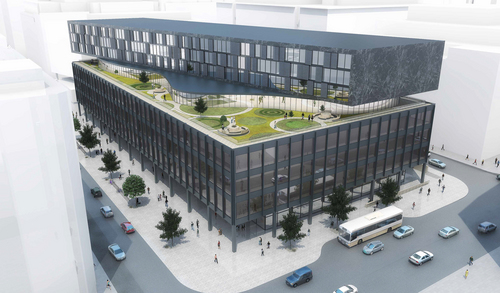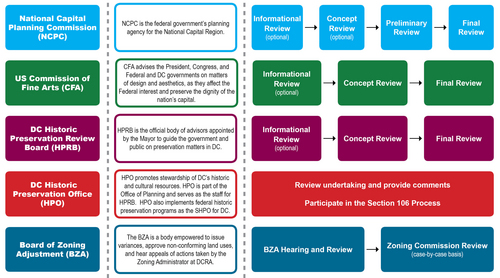Residential on top of the MLK library just doesn’t work
The DC Public Library considered adding three floors of housing on top of the Martin Luther King, Jr. library, but recently backed off. Preservation concerns and opposition from activists were part of the reason, but the real issue was that the finances didn’t work.

One mixed-use option for development of the MLK library. All rendering photos from Mecanoo/Martinez + Johnson via NCPC.
When the library trustees picked Mecanoo and Martinez + Johnson as the architects to rehabilitate the downtown library a year ago, they stressed that naming the firm as their design competition winner was only the start of the process. That has proven very true, as evidenced by the multiple options (pictured throughout this post) the team has had to produce since then.
At the end of January, after a year of negotiating, engagement, and redesign, the trustees voted to abandon the more ambitious designs. DCPL still wants to build on top of the library, but it’s asked Mecanoo and Martinez + Johnson to go with something smaller and not mixed-use.
Instead, library officials are now considering two new designs, each with only a single new floor atop the existing building.

An alternative design that more closely models the the library’s original 1972 design by Ludwig Mies van der Rohe.
Up top, more floors didn’t add up
Financially, not pursuing a mixed-use addition was a relatively simple decision. CBRE, a real estate conglomerate, valued the remaining developable space at at $27.8 million, which is only 10-15% of what the proposed renovations would cost. A cost-benefit analysis by local developer Jair Lynch Partners saw this value as not worth the challenges.
CBRE concluded that office tenants would give the city the most value for the three extra floors. But from the beginning, the library has wanted to disrupt downtown’s office monoculture, and building more offices doesn’t do that. Rental apartments would bring in less annual revenue, particularly if they incorporated affordable housing. A hotel wasn’t an option because the area is already saturated with high-end hotels. Another challenge is that the building would likely need more parking beyond the current single floor. The appraisal included the cost of a valet or automated parking system; both might still be unappealing to a developer, and adding a new floor of parking below would be unimaginably expensive.
Difficulties in arranging public-private partnerships also pushed the library toward a simpler design. For the city, recouping investment is a multi-decade process; most developers, on the other hand, look for a five-year return. According to Lynch, other concerns like developing a unique ownership structure, or even changing the zoning, made the proposition too risky for the financiers.
Going forward, the library may choose to reinforce the building to support a design like the one Mecanoo and Martinez+Johnson proposed last year. That’s similar to what happened with the Tenley-Friendship library, where developers have the option to add a tower in the future. That also means that the city can’t sell the air rights to the site, worth $27.8 million.
The final way to use private money to fund the renovation would be to sell the library’s historic preservation tax credits. National landmarks are eligible for credits meant to defray the cost of restoration, and public entities can sell the benefits to third parties. The market analysis suggested a tax sale at MLK could net $20-30 million.
Below, a long process for what is approved
Even without the mixed-use addition, the renovation still faces DC’s legendary design review process.
So far, all of the changes to the competition-winning entry have responded to historic preservation concerns. But the designers have to get approval from a number of agencies that deal with more than preservation.
- Though the District owns the library building, any projects in this part of DC also require input from the federally-run National Capital Planning Commission (NCPC). NCPC will have to conduct an Environmental Assessment and a Cultural Resources Study.
- If the library decides to sell its historic preservation tax credits, it has to bring in the National Park Service (NPS) which runs the tax credit program. Even if the other agencies approve of the design, NPS could deem the changes to be too invasive.
- The design team has received positive feedback from the the US Commission of Fine Arts (CFA). In January, CFA members asked for a more decisive approach, favoring more open space inside and additions that contrast stylistically from the Miesian architecture.
- Finally, the Historic Preservation Review Board has to approve changes to the building, which Ludwig Mies van der Rohe designed in 1972 and which is both a national and local landmark.
All of these boards’ reviews include public input, but they usually only hear from a limited audience. The more the public engages with this project, the greater the chances it meets the entire community’s needs.
Correction: This article has been changed from the original version to make it clear that all three pictured renderings came from Mecanoo/Martinez + Johnson after they won the design competition. You can see the designs submitted for the competition here.


